What To Look For When Buying A Used Dirt Bike
What to Look for When Ownership a Used Dirt Cycle
When buying a used dirt bike, wait for these telltale signs that the bike has been used and abused so...
Whether y'all're new to clay bikes or a seasoned veteran, you don't desire to waste money on someone else's junk. Here, our resident ii-wheeled experts offer tips on what to await for when buying a used clay bike.
Check the hours on the bicycle
Some bikes come from the factory with an hr meter installed. Sometimes, enthusiasts install an aftermarket 60 minutes meter. If the bike is equipped with an hour meter, cheque the amount of time on the wheel.
On a two-stroke bike, college hours come with less take chances. 2-strokes tin can oft last two or iii times longer than four-strokes. And, while they may lose some power over time, they're less probable to suffer meaning engine damage that requires expensive repairs.
Things are dissimilar when buying a used four-stroke dirt cycle, however. They typically crave a top-finish rebuild about every fifty hours. Otherwise, the piston can clothing out and cause expensive engine damage. Inquire the owner if the cycle has been rebuilt. Search online for recommended rebuild intervals. If you consider ownership a loftier-hour four-stroke dirt bike that hasn't been rebuilt, the toll should reflect that; utilise it as a negotiating tool.
Check the engine oil
Ask the owner near his or her maintenance practices. How has the bike been maintained? On four-strokes, how often did they change oil? Since dirt bikes only hold nearly one quart of oil, near riders change oil frequently.
Pull the dipstick and look at the oil, if possible. Wait for shiny particles in the oil, which indicate the presence of metallic and excessive wear. Particles can point a bearing, transmission gear or other component is declining.
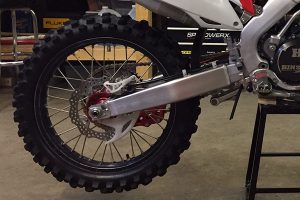
Examine the rear suspension, swing arm and linkage
This is an important step when buying a used clay bike.
Push button down hard on the seat. The bike should rebound in a controlled fashion, not similar a pogo stick. Climb aboard the bike and bounciness on the seat to ensure it offers controlled dampening.
Inspect the rear shock for oil leaks by looking for oil and dirt buildup at its base of operations. If oil leaks and collects on the daze, dirt will stick to it. A rear-daze rebuild costs at least $100, so keep that it mind if you lot notice problems. Riders commonly tin can't rebuild a rear shock themselves because they don't have admission to pressurized nitrogen or the special tools required.
Check the swing arm for excessive play, which holds the rear bike to the frame. Likewise inspect the linkage to which the daze connects. Have someone elevator the rear of the cycle an inch or 2 off the ground. Attempt to pull the back tire from side to side to check for lateral movement. Any movement indicates bad bearings or bushings.
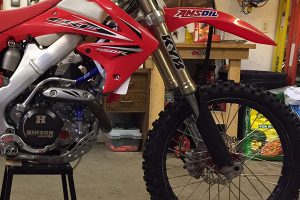
Check the front suspension
This is one of the near abused parts of the bike, meaning it'south something to pay close attention to when buying a used dirt bike. The front end break absorbs the penalization of mile after mile of non-paved surfaces and catching large air. As such, they require periodic maintenance, which some owners overlook.
As with the rear shock, check for oil leaks. Run your mitt over the tubes to bank check for oil. Look for dirt buildup where oil may exist leaking. Examine fork condition, besides. The forepart suspension requires new oil and perchance seals every fifty-100 hours, which may run yous upwardly to $200 for a rebuild. Check out our step-by-step video to do it yourself.
Examine the tires and wheels
While you're looking at the pause, check tire and wheel condition. Clay bikes go through tires rather rapidly, then worn tires tin can influence your negotiation when buying a used dirt bike. Wait for cracks or checking, which indicate the bike isn't used much or the owner isn't changing tires often.
Run your fingers over the spokes. They should all be tight and in good shape. Loose spokes indicate the rim is out of true, which could mean the owner hit one likewise many rocks or other obstacles. New rims are expensive and a possible reason to walk abroad if you're not willing to spend the coin to replace them.
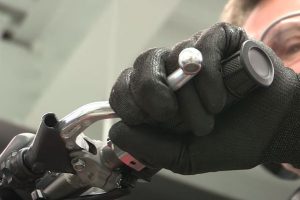
Listen to the engine & shift through the gears
No inspection of a used clay wheel is complete without starting the engine.
It should kickoff readily and run smoothly. Watch for excessive smoke from a two-stroke, which might take a few seconds to fifty-fifty out after information technology's started cold. Mind for any aberrant sounds or loud noises that might indicate piston knock. Rev the engine; it should sound polish.
Take a ride if yous can. This is your hazard to ensure the bike pulls well through the gears and shifts smoothly. Ensure the clutch doesn't skid or grab. Yous should be able to progressively shift through the gears with no issues and easily find neutral.
A slipping or grabbing clutch is a great diagnostic tool; it can point to worn oil, depression-quality oil, worn clutch plates or even a faulty manual.
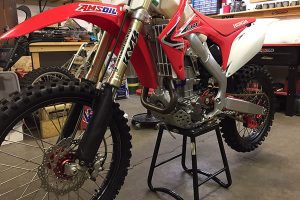
Give it a general visual inspection
Walk around the bike and await information technology over closely. Is the plastic destroyed? That'due south an indication the bike was ridden hard and spent too much time on its side. Look at the side cases of the motor where the passenger'south boots rub. A lot of clothing ways the bike has accumulated a lot of miles.
On a two-stroke, expect for dents in the expansion chamber, which ofttimes bears the brunt of falls. Look for scratches and general wear-and-tear that indicate the bike has been abused. Are the ends of the handles beat upward? Once more, that indicates the bicycle has spent too much time on its side.
What size dirt bike practise I need?
It's important to understand what size cycle yous need when ownership a used dirt bike.
Size your bike based on your skill level. If yous're new to the sport, exist honest nigh your abilities and cull accordingly. Don't buy a powerful 450 assuming yous can "ride your way into it." Too much power and too much cycle increase your chances of having an accident and ruining what can be a neat hobby.
If yous're new or yous're smaller in stature, lean toward a 125 or 150. A dirt bike of this size is easier to handle, less expensive to purchase and maintain, and oftentimes delivers excellent power, particularly modern bikes.
If you lot're an intermediate rider or larger in stature, a 250 will provide a frame about the same size as a 150, just with more power.
Use a good dirt bike motor oil
After you purchase your bike, make certain to use a good motor oil to become the most years and all-time performance from your ride.
AMSOIL Synthetic Dirt Bike Oil's superior friction-immovability properties helpminimize clutch slippage, fade and chatter, giving ridersconsequent clutch experience during takeoffs or when maneuvering around obstacles on the trail.
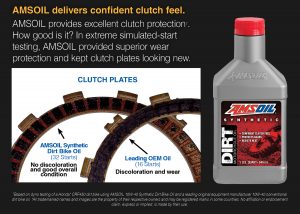
In two-stroke bikes, we recommend AMSOIL DOMINATOR Synthetic 2-Stroke Racing Oil.
- Fantabulous film strength for high-heat, high-rpm motors
- Anti-friction formula for maximum power
- Burns clean; helps prevent ring sticking and plug fouling
- Protects coated and non-coated racing pistons
What To Look For When Buying A Used Dirt Bike,
Source: https://blog.amsoil.com/what-to-look-for-when-buying-a-used-dirt-bike/
Posted by: aldereteyetwall.blogspot.com


0 Response to "What To Look For When Buying A Used Dirt Bike"
Post a Comment